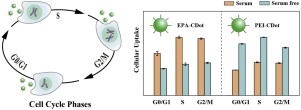当前位置:
X-MOL 学术
›
Colloids Surf. B Biointerfaces
›
论文详情
Our official English website, www.x-mol.net, welcomes your
feedback! (Note: you will need to create a separate account there.)
Effects of carbon dots surface functionalities on cellular behaviors - Mechanistic exploration for opportunities in manipulating uptake and translocation.
Colloids and Surfaces B: Biointerfaces ( IF 5.4 ) Pub Date : 2019-05-14 , DOI: 10.1016/j.colsurfb.2019.05.027 Gui-Hua Yan 1 , Zheng-Mei Song 1 , Yuan-Yuan Liu 1 , Qianqian Su 1 , Weixiong Liang 2 , Aoneng Cao 1 , Ya-Ping Sun 2 , Haifang Wang 1
Colloids and Surfaces B: Biointerfaces ( IF 5.4 ) Pub Date : 2019-05-14 , DOI: 10.1016/j.colsurfb.2019.05.027 Gui-Hua Yan 1 , Zheng-Mei Song 1 , Yuan-Yuan Liu 1 , Qianqian Su 1 , Weixiong Liang 2 , Aoneng Cao 1 , Ya-Ping Sun 2 , Haifang Wang 1
Affiliation

|
Carbon dots (CDots) for their excellent optical and other properties have been widely pursued for potential biomedical applications, in which a more comprehensive understanding on the cellular behaviors and mechanisms of CDots is required. For such a purpose, two kinds of CDots with surface passivation by 3-ethoxypropylamine (EPA-CDots) and oligomeric polyethylenimine (PEI-CDots) were selected for evaluations on their uptakes by human cervical carcinoma HeLa cells at three cell cycle phases (G0/G1, S and G2/M), and on their different internalization pathways and translocations in cells. The results show that HeLa cells could internalize both CDots by different pathways, with an overall slightly higher internalization efficiency for PEI-CDots. The presence of serum in culture media could have major effects, significantly enhancing the cellular uptake of EPA-CDots, yet markedly inhibiting that of PEI-CDots. The HeLa cells at different cell cycle phases have different behaviors in taking up the CDots, which are also affected by the different dot surface moieties and serum in culture media. Mechanistic implications of the results and the opportunities associated with an improved understanding on the cellular behaviors of CDots for potentially the manipulation and control of their cellular uptakes and translocations are discussed.
中文翻译:

碳点表面功能对细胞行为的影响-机械化探索在控制摄取和转运中的机会。
碳点(CDots)具有出色的光学和其他性能,已被广泛地寻求潜在的生物医学应用,其中需要对CDots的细胞行为和机理有更全面的了解。为此,选择了三种被3-乙氧基丙胺表面钝化的CDots(EPA-CDots)和低聚聚乙烯亚胺(PEI-CDots),以评估人宫颈癌HeLa细胞在三个细胞周期阶段(G0 / G1,S和G2 / M),以及它们在细胞中不同的内化途径和易位。结果表明,HeLa细胞可以通过不同途径内化两个CDots,总体上,PEI-CDots的内化效率略高。培养基中血清的存在可能会产生重大影响,显着增强了EPA-CDots的细胞摄取,但显着抑制了PEI-CDots的摄取。不同细胞周期阶段的HeLa细胞在吸收CDots方面具有不同的行为,这也受到培养基中不同的点表面部分和血清的影响。讨论了结果的机械含义以及与对CDots细胞行为的更好理解相关的机会,以潜在地操纵和控制CDots的细胞摄取和转运。
更新日期:2019-05-14
中文翻译:

碳点表面功能对细胞行为的影响-机械化探索在控制摄取和转运中的机会。
碳点(CDots)具有出色的光学和其他性能,已被广泛地寻求潜在的生物医学应用,其中需要对CDots的细胞行为和机理有更全面的了解。为此,选择了三种被3-乙氧基丙胺表面钝化的CDots(EPA-CDots)和低聚聚乙烯亚胺(PEI-CDots),以评估人宫颈癌HeLa细胞在三个细胞周期阶段(G0 / G1,S和G2 / M),以及它们在细胞中不同的内化途径和易位。结果表明,HeLa细胞可以通过不同途径内化两个CDots,总体上,PEI-CDots的内化效率略高。培养基中血清的存在可能会产生重大影响,显着增强了EPA-CDots的细胞摄取,但显着抑制了PEI-CDots的摄取。不同细胞周期阶段的HeLa细胞在吸收CDots方面具有不同的行为,这也受到培养基中不同的点表面部分和血清的影响。讨论了结果的机械含义以及与对CDots细胞行为的更好理解相关的机会,以潜在地操纵和控制CDots的细胞摄取和转运。































 京公网安备 11010802027423号
京公网安备 11010802027423号